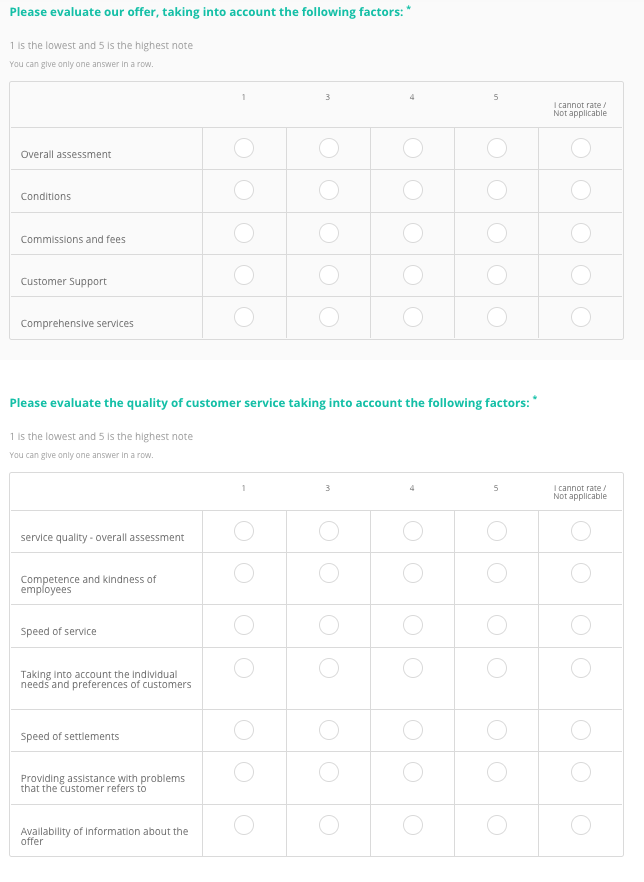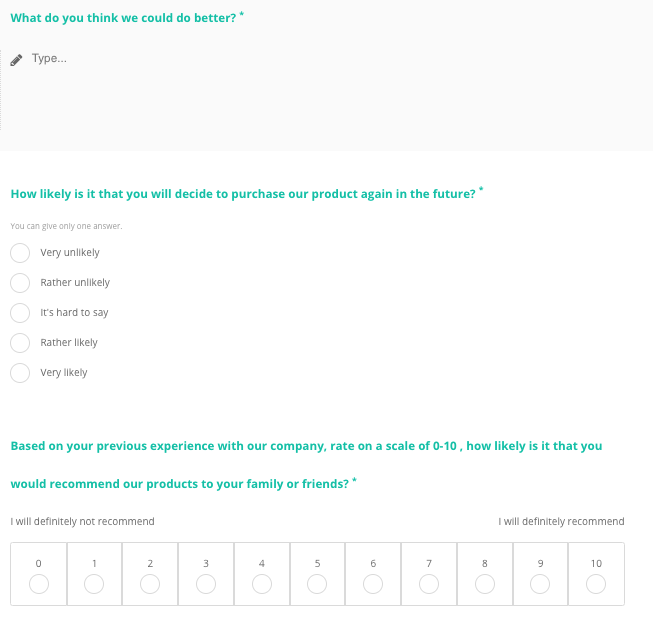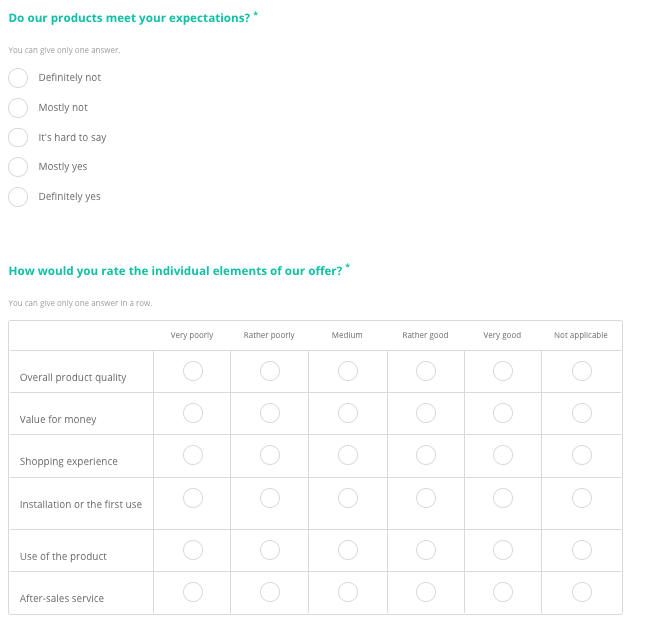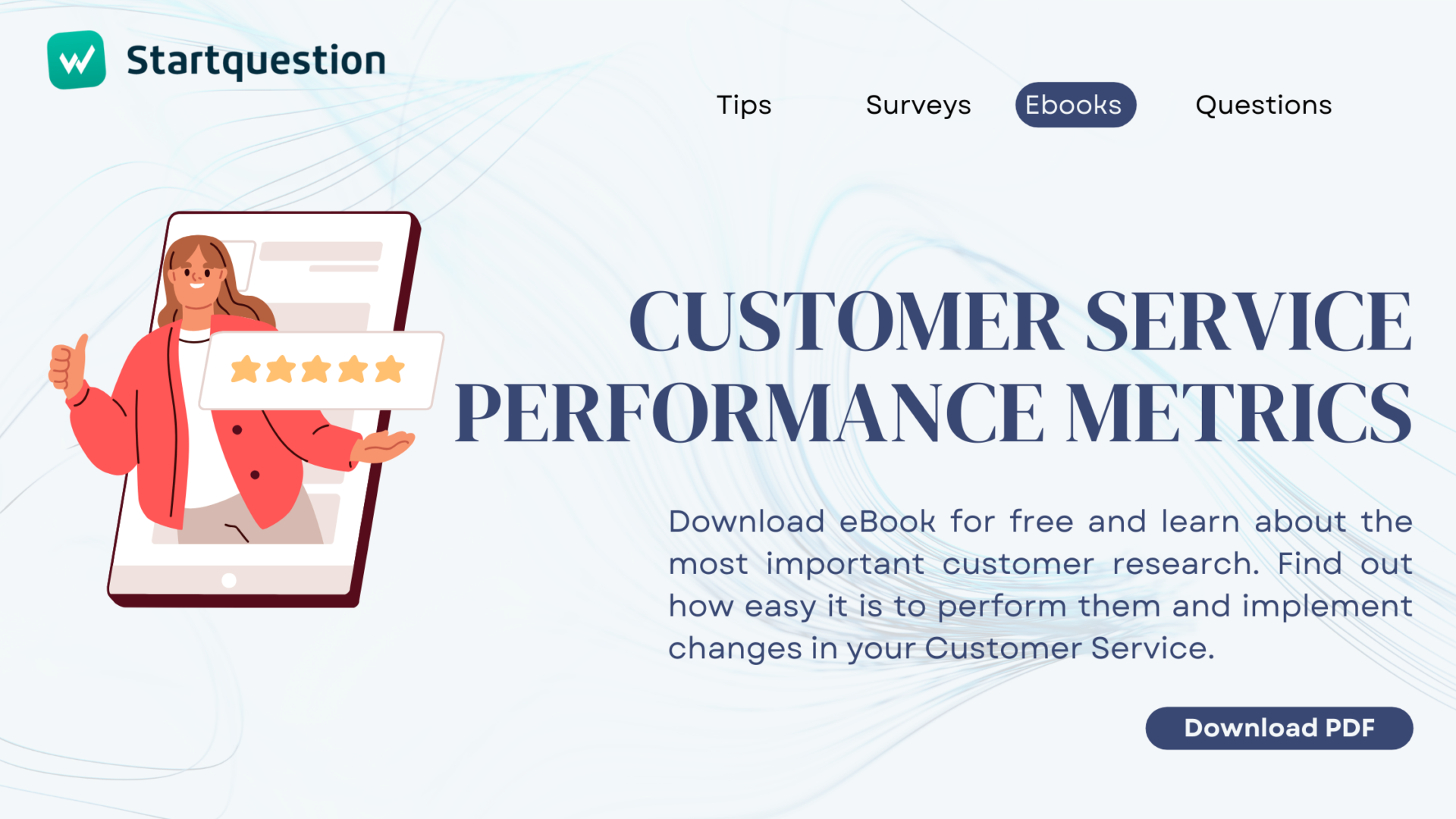High level of customer satisfaction is the business goal of each brand. Regardless of whether you sell products or services, or operate on the B2B or B2C market – it is thanks to satisfied customers (both new ones and those who are already with you) that your company has a chance to achieve success. If you found this article, you probably know it very well and are looking for tips on how to improve customer satisfaction in your company. So let’s not waste time – here are the eight ways in which you will be able to achieve your goal quickly.
In the article you will learn more about:
- what are the fastest and most effective ways to improve customer satisfaction,
- which methods of collecting the customer’s voice (feedback) are the most effective,
- how to use online surveys to improve customer satisfaction,
- what is omnichannel service and why it is worth investing in,
- how to adapt ready-made customer satisfaction survey templates to your needs.
Why is monitoring customer satisfaction so important?
1 in 26 dissatisfied customers actually complain. 91% of them… just walk away
As can be seen from the example of Kolsky’s research customer satisfaction affects the company’s revenues directly. So it’s worth asking yourself: can your company afford to lose 91% of dissatisfied customers? Probably not. And this should be your greatest motivation to work on reducing this level. A good start to such work will be the ability to recognize dissatisfied customers based on the opinions collected. And that’s where we’ll start.
4 Steps to Get Started – Guide to Increasing Customer Satisfaction
In a customer-oriented world, single actions are not enough. In order to increase customer satisfaction, you need to make the 4 activities listed below a permanent element of the Customer Experience strategy of your company:
- Collecting customer feedback: To better understand customer needs, you need to… listen to them. Only that, and as much as that. Online surveys are a great tool to listen to your customers’ voices. By using surveys, you can measure customer satisfaction, their loyalty and find out what you can do better.
- Converting the collected feedback into action: Once you know what your customers want, you need to be able to turn that feedback into action. For example, if some of your customers said that your offer is illegible, you should immediately start changing it – assign tasks to the appropriate people, develop methods of obtaining additional information, etc.
- Improving your products and services. In addition to feedback-changes, you should strive to constantly improve your offer. Develop the process of closing the customer’s voice into a loop and teach your employees how to draw good conclusions from every opinion they receive. In the long term, such activities will allow you to maintain a high level of customer satisfaction.
- Maintaining continuous contact with customers. What we mean here is sharing information about changes made on the basis of their feedback. This will allow not only to maintain awareness and contact with the brand, but most of all it will show the customers that your company appreciates their opinions.
8 tips to increase customer satisfaction
As explained above, improving customer satisfaction comes down to collecting customer feedback and then taking the appropriate action. The 8 tips below will help you implement a system of constant listening to the customer’s voice in your business and make changes based on it:
1. Offer multi-channel support and customer service
64% of customers expect real-time support – regardless of the customer service channel used
Research shows that the level of customer satisfaction is closely related to how easy it is for them to contact you. Customers make purchases using various channels and devices, so you should enable them to contact and provide service in the channel chosen by them, not the channel you have imposed. The most frequently used customer service channels are currently:
- live chat,
- chat on social media, e.g. Messenger,
- email support,
- telephone support.
The biggest advantage of multi-channel support is the ability to engage customers in their preferred method of communication. Therefore, make sure that you offer the highest quality support not only by email or telephone, but in all available channels. This makes it possible to increase not only credibility and trust in the brand, but also long-term customer satisfaction.
How do you know if your customers are satisfied with the quality of service in a given channel? The answer is simple – for this purpose, use a customer satisfaction survey. We have prepared a ready-made research template for you that you can quickly adapt to your needs and thanks to which you will learn:
- how the individual communication channels and service aspects are assessed,
- which methods of contact with the customer should be improved,
- whether customer service employees are doing well in carrying out their tasks.

An example of a customer satisfaction survey after contacting the Customer Service Department prepared by experts from Startquestion
2. Make collecting customer feedback a part of your business
Companies defined as customer-centric are 60% more profitable than companies that are not customer-focused.
Who knows better what your customers want than… themselves? As we have already mentioned, customer feedback is one of the most powerful assets your business can have. This is a clear indicator of how your products and services are received and whether the effort you put into growing your business makes sense.
The first step to becoming a customer-oriented company and working out a process for collecting their opinions. In a separate article, we shared the knowledge about how to close the customer’s voice into a loop. You will learn step by step not only how to create a survey, but also how to use the accumulated knowledge in practice.
However, as a first step, we advise you to start regular customer satisfaction surveys, e.g. in the form of periodic surveys. We have prepared ready-made customer satisfaction survey templates that you can freely adapt to your needs. Thanks to regular customer surveys:
- you will easily notice drops in satisfaction and you will be able to immediately start fixing the problem,
- you will learn which factors affect the growth and which ones decrease customer satisfaction,
- you can easily create reports, thanks to which you will be able to hand over customers’ feedback to other colleagues, departments and decision-makers in the organization.

Fragment of an example of a customer satisfaction survey (relational NPS) prepared by experts from Startquestion
3. Ask for feedback regularly and using the same method
Companies focused on customer service generate revenues 4-8% higher than their competitors in the same industry.
What tools do you use to measure customer satisfaction? Probably your primary method of measurement, as in many other companies, is NPS (Net Promoter Score). This method makes it possible to find out what is the likelihood of a customer recommending your brand , products or services to their family or friends. Other popular methods of measurement are e.g. general customer satisfaction survey – CSAT or Customer Effort Score, used to measure the effort required to handle a matter.
Regardless of which method you choose, you must meet two conditions: regularity and consistency in action. Regularity means that a one-time survey, or even a survey sent to customers once a year, is not enough. Set up periodic mailing dates and make sure that the survey always reaches the right customers (don’t forget about sending reminders to complete the survey). Consistency, on the other hand, means using the same method all the time. Of course, if you have the time and resources to do so, you can conduct several types of studies simultaneously, e.g. Net Promoter Score and Customer Effort Score. However, it is important that you compare the results of cyclical research conducted using the same scales and methodology – only then will you have a chance to draw good conclusions and gain real insight into changing customer opinions.
Startquestion customers can benefit from ready-made NPS research examples:

Fragment of an example of a product satisfaction survey (relational NPS), prepared by experts from Startquestion
4. Collect opinions at all points of contact
You cannot stop at collecting opinions, e.g. only after the customer contacts the support department. You will get a real picture of satisfaction after collecting feedback from as many points of contact as possible during the customer’s journey with your company.
As we mentioned earlier, you can choose different types of surveys:
- You can send a CSAT satisfaction survey, e.g. after closing an issue, to the customer’s email address,
- evaluation of the website after visiting it or particular pages,
- Customer Effort Score research after contact with the technical support department,
- Relational NPS after completion of a larger transaction, when some relationship with your brand is already established.
If you collect customer feedback across all of your channels, you’ll be able to improve the entire customer journey!
5. Do not wait for the customer to give you a rating – ask for it yourself
There is no point in expecting that customers, even after a very positive contact with your company, will assess you on their own, e.g. on Google maps or in social media. Of course, such unsolicited feedback is of great importance and makes a great showcase, but instead of sitting unbothered, you should be actively convincing customers to share them.
Here are a few ways to get positive feedback on external websites or social media faster:
- tell consultants to encourage customers to share their opinions after each contact with the Customer Service Center
- offer a gratification, e.g. a discount for issuing a rating (not necessarily a positive one!),
- after completing the satisfaction or NPS survey, place a link to the rating on the thank you page for taking part in the survey. We provide some hints in the Startquestion Guide on how to easily and quickly collect positive reviews on Google using online surveys for this purpose.
6. Make sure that the customer’s feedback reaches the entire organization
Keeping the customer’s opinion at only one department or (worse!) one employee is the worst thing you can do. Let’s face it – customer feedback is useless if not heard by everyone. Therefore, analysing customer opinions, responding to them and changes made on this basis should be the result of the actions of the entire company, and not of one team appointed to this group or several designated employees.
Who should the feedback go to? Here are some examples:
- if a review appeared in the user experience survey and concerns errors in an application, it is best to forward it to the product team, IT or Product Owner,
- if a customer complains about your latest campaign in social media, this feedback should reach people responsible for marketing as soon as possible,
- if you see that the results of the Customer Effort Score have dropped suddenly, don’t wait -make sure you hand them over to the Customer Service department immediately.
The more feedback you provide inside the organization, the better. The more people in your company collaborate on customer feedback and are committed to improving their customer experience, the greater the chance of improving your overall satisfaction level.
In your company, there should be a designated person (maybe you are that person?) or a team that keeps an eye on customer orientation, supports customer-oriented activities and watches over the customers’ feedback being shared with other departments. In an ideal scenario, each team in your organization should have a specially allocated time each month to analyse customer feedback, which comes from, for example, online surveys, phone calls or reaches them from other departments.
There are many ways to improve the flow of customer information and research results in your business. We offer, among others:
- alerts, i.e. notifications that come to the email address of a designated person, if a condition is met – e.g. in the work survey of the Customer Service Department, a rating of 1 (lowest) appears. Then, the supervisor of this department and, for example, the employee who is the subject of the opinion, receives an email with the result and justification. Thanks to this, this person does not have to log in to the feedback tool, such as Startquestion – all information will be included in the message.
- periodic reports, containing either a summary of all research results from a given period, or only those results that are of interest to a specific recipient, e.g. marketing department,
- a separate channel with feedback on the Slack messenger, in which all interested parties will receive notifications about each new customer feedback or assessment that meets certain criteria, e.g. a critic from the NPS survey,
7. Reply to ALL opinions
Whether your customers give you a positive or negative feedback, it’s worth taking the time to respond to it. Contrary to what it may seem, answering good opinions is also important because:
88% of consumers trust user reviews as much as they trust personal recommendations.
Building the so-called social proof can encourage potential customers to buy from you.
Therefore, if the customer is satisfied, you can use it to build a positive image of your brand. All you have to do is contact this customer and ask for permission to use the opinion when creating a review, case study or other material that you will publish on the website or in social media.
But… it also works the other way around. If you received negative feedback also don’t leave it unanswered. Here, discussing the topic and asking for the reason for the assessment is even more important – find out what made the customer unhappy, then change your product or services and thus reduce the likelihood of similar customers leaving in the future.
A very helpful tool in ensuring that no customer opinion goes unanswered is an email sent after the survey is filled out. This is the Startquestion feature, thanks to which, after taking part in the survey, respondents receive a specific message in selected situations. This can be, for example, an email of appreciation for taking part in the survey or confirmation of completion. Of course, it is worthwhile for you to personalize such messages as much as possible, but just saying thank you for filling in and reassuring the respondent that his or her voice has been heard is a good first step.
8. Treat negative feedback not as a failure but as an opportunity!
Complaints and negative comments are the best source of valuable feedback. It is thanks to their analysis that you can precisely locate the sources of problems and find out exactly what your customers want.
Therefore, negative feedback should be treated not as a failure but as an opportunity. This is a great opportunity to build closer relationships with your customers. Here are some tips to help you develop best practices for engaging with negative or problem reporting customers:
- Always contact the customer immediately after receiving negative feedback – do not wait too long, because there is a chance that he/she will forget about the case or will not be able to provide you with important details,
- During the contact, have a ready solution to the problem, or at least inform the customer about the progress in solving it,
- Only respond publicly (e.g. on social media) to negative feedback when you are sure that it will not trigger an even more emotional reaction from the customer and harm your business. Otherwise, contact the author of the opinion in person, in a private message.
- Keep up-to-date with the reviews issued by your customers
- If he or she has already taken steps to resolve the issue, please let everyone who reports it know.
And remember:
More than two-thirds of users trust reviews more if they are a combination of negatives and positives.
As a result, even negative evaluations can become the strength of your company! All you need to do is learn to respond to them properly.
Improve customer satisfaction with online surveys
We presented our verified methods of increasing customer satisfaction. They will help you achieve success, provided that… after reading this article, you actually begin to implement them into your company’s life and processes. For starters, it is worth taking care of the appropriate measurement of the customer satisfaction index at various points of contact. For this purpose, use the ready-made survey templates for customers, created by experts at Startquestion.
Using Startquestion you can try creating customer satisfaction surveys for free for 14 days. We keep our fingers crossed and wish you the same NPS promoters, 5 stars in satisfaction surveys and of course – profits 🙂




